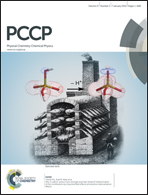The influence of the electrolyte on chemical and morphological modifications of an iron sulfide thin film negative electrode
Abstract
The chemical and morphological modifications of FeS thin film as anode material for LiBs have been studied in detail in two classical electrolytes usually used in Li-ion batteries: 1 M LiClO4-PC and 1 M LiPF6-EC/DMC. The X-ray photoelectron spectroscopic (XPS) analysis evidenced the formation of a solid electrolyte interphase (SEI) that contains a more significant amount of inorganic salt residues formed in LiPF6-EC/DMC than in LiClO4-PC, which is likely to increase the ionic resistivity of the SEI, thus impeding the lithiation–delithiation in the first cycles while improving its reversibility. Ion depth profiles performed by time-of-flight secondary ion mass spectrometry (ToF-SIMS) show volume expansion–shrinkage of the thin film leading to cracking and pulverization of the electrode material, which is also confirmed by scanning electron microscopy (SEM) analysis. The prolonged cycling results in penetration and accumulation of the electrolyte in a bulk electrode with accumulation of the inorganic species in the inner part of the SEI enhanced in a fluoride-containing electrolyte. Cycling in these two different electrolytes leads also to formation of two different electrode morphologies: with a compact electrode structure formed in LiClO4-PC and a foam-like, porous structure in LiPF6-EC/DMC. A model of this conversion-type thin film electrode modification based on these thorough spectroscopic and microscopic analyses induced by cycling in two different electrolytes is proposed.


 Please wait while we load your content...
Please wait while we load your content...